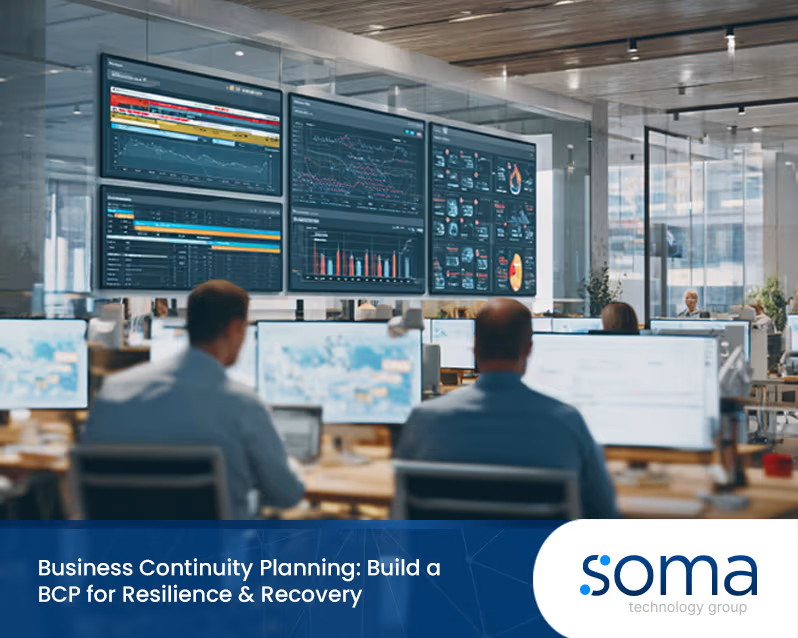
Disaster Recovery Planning: Avoid Mistakes & Improve Recovery
Disaster recovery planning is more than just a checklist—it's a critical part of keeping your business running when things go wrong. Whether it's a natural disaster, cyberattack, or power outage, having a clear plan in place helps protect your data, systems, and business operations. In this blog, you'll learn what disaster recovery planning involves, common mistakes to avoid, the types of disasters to prepare for, and how to build a reliable recovery plan. We'll also cover recovery strategies, business continuity, and how to choose the right disaster recovery solutions for your needs.
[.c-button-wrap2][.c-button-main2][.c-button-icon-content2]Contact Us[.c-button-icon-content2][.c-button-main2][.c-button-wrap2]
What is disaster recovery planning, and why does it matter
Disaster recovery planning is the process of creating a structured approach to respond to unexpected events that disrupt your IT systems and business functions. These events could be anything from a cyberattack to a flood damaging your data centre. The goal is to minimise downtime, protect data, and restore services quickly.
A solid disaster recovery plan outlines how to back up data, recover systems, and communicate with stakeholders during a disruptive event. It also includes a business impact analysis to understand how different incidents affect your operations. Planning helps reduce the risk of data loss and ensures your team knows what to do when disaster strikes.

Common recovery plan mistakes that cost businesses
Even with the best intentions, many businesses make avoidable mistakes when building their disaster recovery plan. Here are some of the most common ones and how to avoid them.
Mistake #1: Not testing your plan regularly
Creating a plan is only the first step. If you don’t test it, you won’t know if it works. Regular testing helps identify gaps and ensures your recovery team knows their roles.
Mistake #2: Ignoring recovery time objectives
Failing to define your recovery time objective (RTO) can lead to longer downtime than your business can afford. Set realistic RTOs based on your business needs and system importance.
Mistake #3: Overlooking backup verification
Backing up data is essential, but if you don’t verify those backups, you might find out too late that they’re incomplete or corrupted. Always check that your backups are working.
Mistake #4: Relying only on on-premises solutions
If your only recovery option is stored in the same location as your main systems, a natural disaster could wipe out everything. Use offsite or cloud-based options for added protection.
Mistake #5: Not involving key stakeholders
A disaster recovery plan isn’t just for IT. Involve stakeholders from across the business to ensure all critical business functions are covered and everyone understands their role.
Mistake #6: Failing to update the plan
Your systems, staff, and business processes change over time. If your plan doesn’t reflect those changes, it won’t be effective. Review and update it regularly.
Mistake #7: Underestimating the business impact
Without a proper business impact analysis, you might not realise how much an outage can cost. This can lead to underinvestment in recovery solutions and longer recovery times.
Key benefits of strong disaster recovery planning
A well-prepared disaster recovery plan offers several business advantages:
- Reduces downtime by restoring systems quickly after a disruptive event
- Protects critical data and prevents permanent data loss
- Supports business continuity and keeps operations running
- Builds customer trust by showing you're prepared for emergencies
- Helps meet compliance requirements for data protection and reporting
- Improves communication and coordination across departments during recovery

Understanding the types of disasters to prepare for
Disasters come in many forms, and your plan should account for all relevant risks. These include natural disasters like floods or fires, cyber threats such as ransomware, and technical failures like hardware breakdowns. Human error and power outages are also common causes of disruption.
Each type of disaster affects your systems differently. For example, a cyberattack may target your data, while a flood could damage your physical infrastructure. Understanding the types of disasters your business is most likely to face helps you build a more effective recovery plan.
Types of disaster recovery strategies and when to use them
Different recovery strategies suit different business needs. Here’s a breakdown of the most common types and how they work.
Strategy #1: Backup and restore
This is the most basic approach. Data is backed up regularly and restored after a failure. It’s cost-effective but may result in longer recovery times.
Strategy #2: Hot site
A hot site is a fully functional duplicate of your IT environment at another location. It allows for near-instant recovery but is more expensive to maintain.
Strategy #3: Cold site
A cold site is a space with infrastructure but no active data or systems. It’s cheaper but takes longer to get up and running during a disaster.
Strategy #4: Warm site
A warm site offers a middle ground. It has some systems and data preloaded, allowing for faster recovery than a cold site without the full cost of a hot site.
Strategy #5: Cloud-based disaster recovery
This strategy uses virtual machines and cloud infrastructure to replicate your systems. It’s flexible and scalable, making it ideal for growing businesses.
Strategy #6: Managed disaster recovery services
Some businesses choose to outsource their recovery process to a provider. This ensures expert support and frees up internal resources.
Strategy #7: Hybrid approach
Combining on-premises and cloud-based solutions can offer the best of both worlds. It provides redundancy and flexibility while managing costs.

Planning for implementation and recovery team coordination
Implementing your disaster recovery plan involves more than just writing a document. You’ll need to assign roles, train your recovery team, and ensure your infrastructure supports your recovery time and recovery point objectives.
Make sure your team knows how to access backups, restore systems, and communicate with other departments. Include clear steps for each stage of the recovery process, from identifying the issue to restoring full business operations. Regular drills help keep everyone prepared.
Best practices for disaster recovery planning
To get the most from your disaster recovery efforts, follow these proven best practices:
- Document every step of your recovery process clearly and concisely
- Involve all departments in planning to cover all business functions
- Use cloud-based disaster recovery for flexible, scalable protection
- Review and test your plan at least twice a year
- Keep copies of your plan accessible both online and offline
- Monitor changes in your IT environment and update your plan accordingly
Following these steps helps ensure your business is ready to respond quickly and effectively.

How Soma Technology Group can help with disaster recovery planning
Are you a business with 20 to 1000 employees looking to improve your disaster recovery planning? If you're growing and need a reliable way to protect your systems and data, we can help. Our team understands the unique needs of businesses scaling their operations and the importance of minimising downtime.
At Soma Technology Group, we offer tailored disaster recovery solutions that fit your infrastructure, budget, and compliance needs. Whether you need help building a recovery plan from scratch or improving an existing one, our team is ready to support you.
[.c-button-wrap2][.c-button-main2][.c-button-icon-content2]Contact Us[.c-button-icon-content2][.c-button-main2][.c-button-wrap2]
Frequently asked questions
What should be included in a disaster recovery plan?
A disaster recovery plan should include detailed steps for restoring IT systems, data, and business operations after a disruptive event. It must outline roles and responsibilities, communication protocols, and timelines for recovery. It should also define your recovery time objective and recovery point objective.
Include a business impact analysis to understand how different systems affect your business functions. Don’t forget to list all backup procedures, data centre locations, and how to restore services. Regular updates and testing are also essential.
How do I choose the right recovery strategies for my business?
Start by assessing your business needs, system priorities, and risk tolerance. Some businesses may need fast recovery times, while others can afford longer downtime. Your choice of recovery strategies should reflect your recovery time and recovery point objectives.
Consider the types of disasters you're most likely to face, such as cyber threats or natural disasters. Then decide whether a cloud-based disaster recovery solution or hybrid approach works best for your setup.
What are the most common types of disasters businesses face?
Businesses often face natural disasters like floods and fires, as well as cyber threats such as ransomware or data breaches. Technical failures and human error are also frequent causes of disruption.
Each type of disaster can affect your systems differently. That’s why your disaster recovery plan should cover a wide range of scenarios, including outages, data loss, and physical damage to infrastructure.
Who should be part of the recovery team?
Your recovery team should include IT staff, department heads, and key decision-makers. Each member should have a clear role in the recovery process, from managing backups to restoring systems and communicating with stakeholders.
Make sure the team is trained and familiar with the disaster recovery plan. Regular drills help ensure everyone knows what to do during an outage or other disruptive event.
How does cloud-based disaster recovery work?
Cloud-based disaster recovery replicates your systems and data in a secure cloud environment. In the event of a failure, you can quickly switch to these virtual machines to keep your business running.
This approach offers flexibility and scalability, making it ideal for businesses that need fast recovery times without investing in a second physical data centre. It also supports better data protection and reduces the risk of permanent data loss.
What is the difference between disaster recovery and business recovery?
Disaster recovery focuses on restoring IT systems and data after an incident. Business recovery goes a step further by ensuring all business operations, including customer service and supply chains, return to normal.
Both are part of a broader business continuity strategy. While disaster recovery handles the technical side, business recovery ensures your people, processes, and services are back on track after a disruptive event.
.svg)
.webp)


